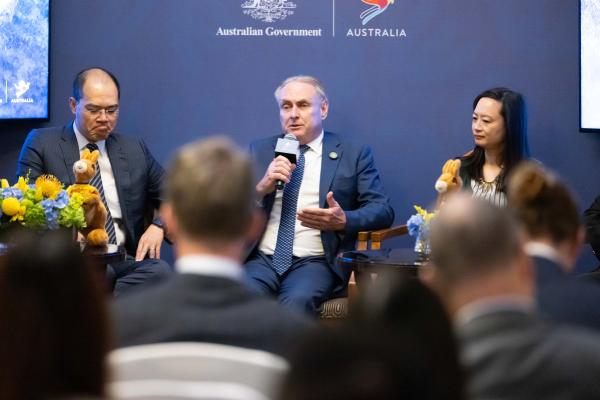Michael Godfrey / DFAT

Marina Yue Zhang, Associate Professor – Research, Australia-China Relations Institute, University of Technology Sydney |
This article appeared in Australian Outlook on september 23 2024.
The 20th annual Canberra Networking Day (CND), hosted by the Australia China Business Council (ACBC), once again underscored the intricate and evolving nature of Australia-China relations. Collaboration is essential, and working towards a practical understanding for beneficial trade relations will be key.
Since Foreign Minister Penny Wong’s breakthrough visit to Beijing in 2022, the bilateral relationship has undergone significant transformation. Early in 2023, tensions spiked due to Australia’s commitment to the AUKUS agreement, and media narratives hinted at escalating conflict. Yet, as the year unfolded, both nations softened their rhetoric, resuming leader-level meetings and signalling a stabilisation in their relationship.
At the CND conference in Parliament House, Canberra, both the Trade Minister and the Shadow Trade Minister focused on resolving specific issues, such as lifting the last remaining export restriction on Australian lobster—a remnant of China’s pandemic-era trade barriers. However, Wong presented a broader strategic vision. ‘Australia has a limited domestic market, and its economic security relies on trade,’ she emphasised, underscoring the importance of strong trade ties, particularly with China, Australia’s largest trading partner.
Wong also highlighted the need for resilience, pointing to the supply chain disruptions witnessed during the pandemic. ‘One lesson from the pandemic, political shifts, and climate impacts is the need for secure supplies in critical areas,’ she noted, stressing Australia’s pursuit of ‘strategic equilibrium.’ This concept envisions a regional order where countries make sovereign choices in their partnerships, rather than aligning with any one major power.
While immediate trade concerns were addressed, Wong’s emphasis on strategic equilibrium signalled a longer-term approach—one that balances Australia’s economic interests with its growing role in shaping the regional order. As Australia refines its China policy, the challenge lies in maintaining this balance between pragmatic economic engagement and geopolitical foresight.
Beyond trade policy, Wong called for a more independent foreign policy. She stressed the importance of mutual understanding, noting, ‘We need to be clear about where we agree and where we don’t. In the past, engagement was lacking, and differences were not well understood. Now, we must ensure clarity in both our agreements and disagreements.’
ACBC President David Olsson echoed this sentiment, acknowledging the complexities of the relationship. ‘Both countries must continuously repair and improve ties in a changing world,’ he said, highlighting the critical role of capabilities in maintaining Australia’s competitive edge. ‘Capability isn’t just about resources and infrastructure,’ he elaborated, ‘it’s about understanding, innovation, and resilience.’
The 200-plus delegates attending the CND, representing businesses, individuals, and industry bodies, expressed cautious optimism. The challenges ahead are significant, but so are the opportunities. Sustained business-to-business, people-to-people, and government-to-government dialogue will be crucial for navigating this vital, complex relationship.
Olsson pointed to sectors such as energy, digital innovation, and sustainable agriculture as foundations for the future of both nations. He specifically highlighted the Green Channel Initiative, through which Australia and China can harness renewable energy to set new global standards during the energy transition. Wong also noted ongoing discussions about further cooperation on global challenges like climate change.
My conversations with delegates—from businesses involved in bilateral trade, professional services, and industry bodies—revealed persistent challenges in cross-border trade and investment. While the China-Australia Free Trade Agreement (ChAFTA) remains a cornerstone of economic ties, many emphasised that a stable bilateral relationship is more critical than ever for fostering trade and investment.
Australia continues to be a vital platform for Chinese companies, particularly as a springboard for global expansion in key sectors like electric vehicles (EVs). For major Chinese EV manufacturers, Australia serves as a crucial gateway to international markets, with key certifications in safety and data management obtained here. Success in Australia positions Chinese firms favourably for further global expansion.
Some expressed concerns about the shifting geopolitical landscape that has heightened scrutiny of foreign investments, particularly in sensitive sectors such as critical minerals. Once governed by market dynamics, these resources are now at the heart of geopolitical contestation. This has sparked a rise in resource nationalism, creating both challenges and opportunities for Australia, a major producer of these essential materials. As the rivalry between the US and China intensifies, critical minerals have become central to both economic and military strategies, positioning Australia at the forefront of this strategic competition. Navigating this landscape will test Australia-China relations, particularly around foreign and trade policy.
There is often a misunderstanding about Australia’s investment environment, particularly among Chinese investors. Chinese investors have realised that they need to adopt more strategic approaches, focusing on partnerships with local Australian companies to navigate the regulatory landscape and align with business practices. Long-term investment strategies, community engagement, and compliance with ESG requirements, including Indigenous rights, are becoming increasingly important for Chinese firms aiming to succeed in Australia.
At this critical juncture, the path forward for Australia-China relations will require nuance, mutual understanding, and a commitment to finding common ground amid differences. In this shifting landscape, building China capabilities and fostering collaboration will be essential for securing Australia’s future prosperity. By balancing economic interests with geopolitical realities, Australia can secure its position in global supply chains and shape the future of regional and global power dynamics. Decisions made today will have profound implications for the nation’s economic resilience and its role in the evolving world order.
Author
Dr Marina Yue Zhang is Associate Professor – Research at the Australia-China Relations Institute, University of Technology Sydney.


